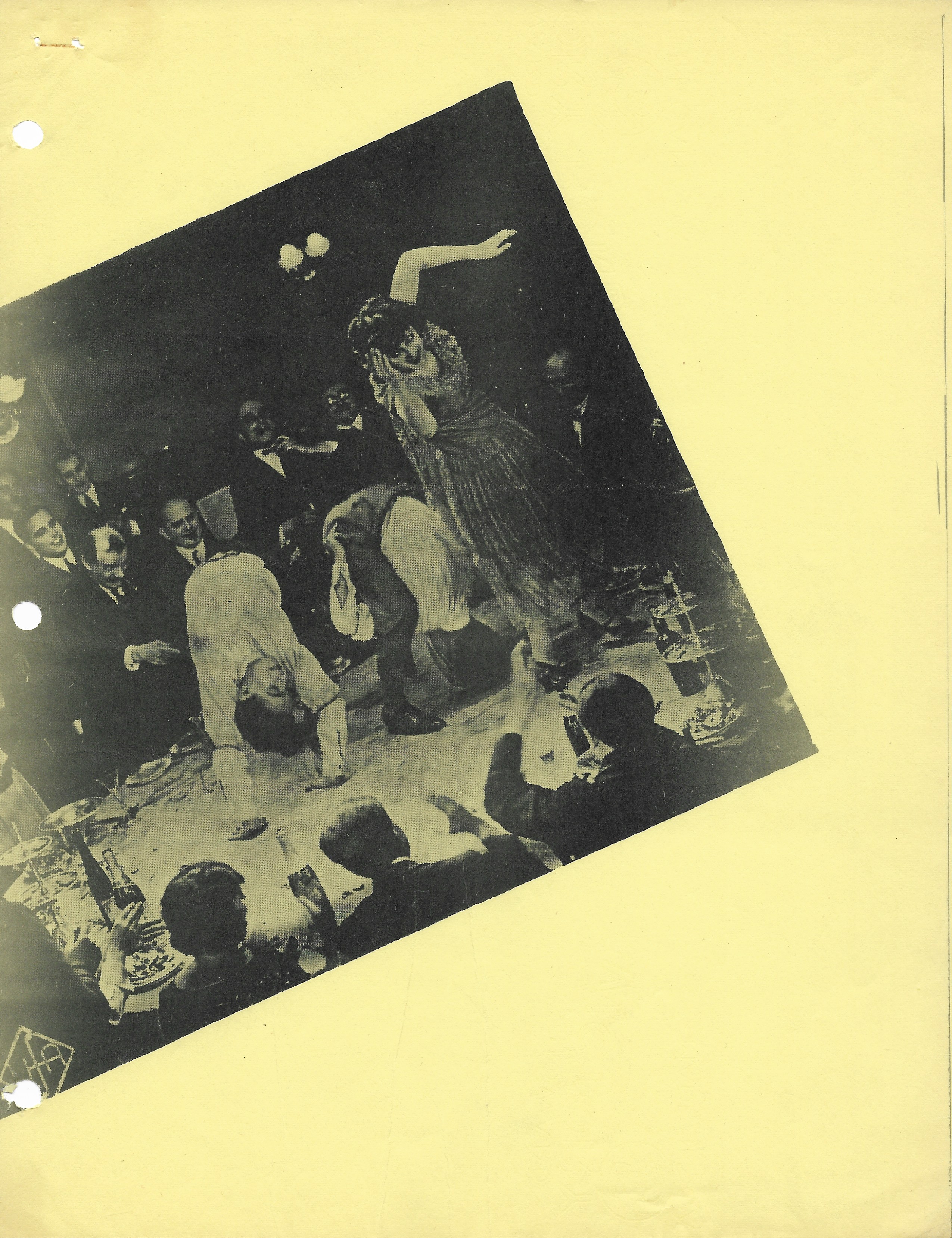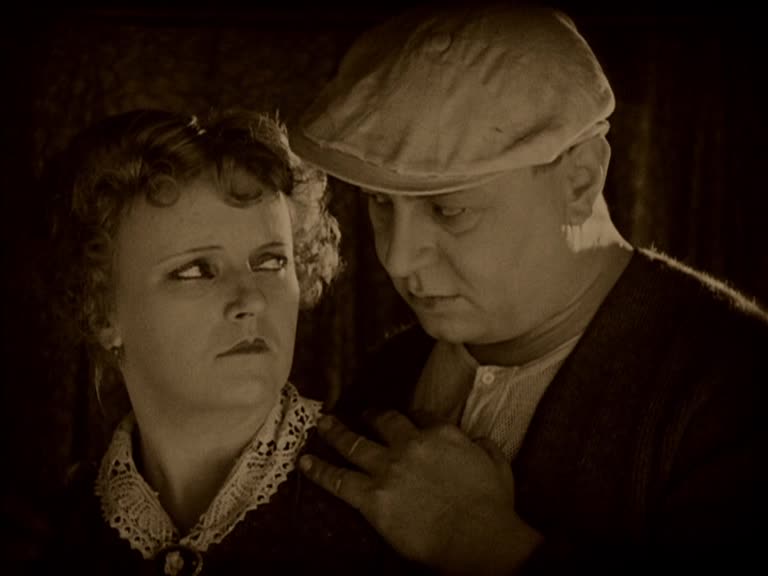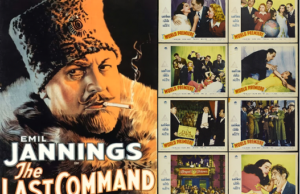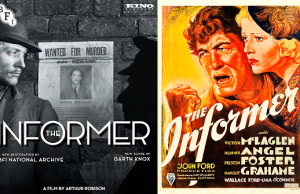Variety (1925)

Toronto Film Society presented Variety (1925) on Monday, January 12, 1953 as part of the Season 5 Main Series, Programme 5.
FIFTH EXHIBITION MEETING – FIFTH SEASON
Monday, January 12, 1953 Doors close 8.15 p.m. sharp
Royal Ontario Museum Theatre
NOTE: Members receiving programme notes by mail
will please bring them to the theatre for
reference; notes distributed at the theatre
are for members not receiving copies by mail.
___________________________________________________________________

O Canada 1 min 48 secs
– the Right Eye Version
– followed by the Left Eye Version
PRODUCTION: National Film Board of Canada, 1952
DRAWN by: Evelyn Lambert
At the last meeting members viewed–and applauded–the right eye version of the new stereoscopic interpretation of Canada’s national song. The Society is considering purchasing the print as a companion piece to God Save the Queen.
3-dimensional films use two separate prints–one for each eye–the same scene being viewed from different angles. It was Norman McLaren who first solved the problem of synthetically giving the sense of depth to drawn or painted images. Two sets of flat drawings were prepared, one for each eye, the perspective of each being slightly different, and the differences being controlled in order to locate the subject matter at any desired point in space.
When viewed with the naked eye, both right and left eye versions have a somewhat out-of-focus appearance, not in the least uninteresting in the case of the stylised treatment of O Canada. NFB chose the right eye version for distribution because it is slightly sharper than the left. For the interest of those who may be curious to compare the two, the left eye version will be played after members are seated. We look forward to the time when it will be possible to project the two synchronously; then each member, with the aid of polaroid spectacles, will experience the three-dimensional effect.
Land of the Long Day Canada 1952 38 mins
WRITTEN & DIRECTED by: Douglas Wilkinson
PHOTOGRAPHY: Jean Roy
COMMENTATOR: John Drainie
Douglas Wilkinson spent eighteen months in the North and returned to Ottawa with enough footage to complete three films. This is reported from several sources to be of outstanding quality–“Sketches of life among the Esquimos on Baffin Island, made with intense feeling and understanding of the people from the North, it is a film of great dignity, of which the National Film Board should be proud.” Again the Society is indebted to Mr. Guy Glover of NFB for permission to show the print before its general release.
INTERMISSION
10 minutes
A FEW NOTES ON THE EXPRESSIVE CAPABILITIES OF THE CAMERA
AFTER PAUL ROTHA
In the early days of the cinema, all shots were taken from a standard distance away from the object, the influence of the stage still being uppermost in the mind of the director. The actors were made to remain discreetly in the background, and gestured into the camera, adjusting themselves to it, as it were, and being extremely conscious of its presence. Griffith is claimed to have been the first director to have broken down this barrier .. the idea of using the close-up to draw attention to a certain object threw a new light on film direction.
It was not until after the war, however, that the Germans realised that practically anything, when lit from the right source, was more dramatic if taken from a position different from the usual eye-level. From that day onwards the camera developed its independence, to be used rightly by a few directors for the strict emphasis of mood, and wrongly by many for the sake of sheer virtuosity. Even now (1929), there are lamentably few directors who have any real knowledge of the use of the camera angle, of when and how to employ it in order to achieve dramatic effect. Of these few, mention may be made of Pabst, Pudovkin, Eisenstein, Feyder, Clair, and Dreyer. In recent years (1949), several directors have made serious study of camera set-up as a means of interpreting dramatic content. Among them should be included Marcel Carné, David Lean, John Huston, Carol Reed and Edward Dmytryk.
.. The principal developments in the capabilities of the camera took place in Germany. Practically every photographic device which is used to emphasise the dramatic power of a shot saw its origin in German Studios. It was Fritz Arno Wagner, Karl Freund, Karl Hoffman, Gunther Rittau, Guido Seeber, Gunther Krampf and their confrères who gave the camera its independence from the hampering tripod.
Camera mobility is completely justified in any direction and at any speed so long as the reason for its movement is expression and heightening of the dramatic content of the shot. Its motion can be forward and backward, from side to side, or up and down. It can move horizontally, perpendicularly, diagonally, circularly and in combinations of these actions in curved or straight movements. In Jeanne Ney, Wagner’s camera was in motion practically throughout the film. So strongly was the dramatic content brought out, however, that the spectator was scarcely conscious of the movement. ..
A pan shot (when the camera pivots on its own axis laterally, or tilts in an up-and-down motion) tends to slow down the action of a scene; cutting tends to quicken the pace. The only clue as to whether panning or cutting should be used in a certain continuity of shots lies in the mood of the scene. If the nature of the latter is to be quick and staccato, then panning will be useless to convey this tempo, cutting being the desirable method. If, on the other hand, the action is slow, dragging, and sad, panning slowly from one person or object to another will produce the required emphasis of mood.
.. Movement which is apt to make the audience conscious of the camera’s presence is absolutely undesirable.
from – The Film Till Now
Variety (Vaudeville) 1925
PRODUCTION: Ufa
SUPERVISION: Erich Pommer
DIRECTION: E.A. Dupont
PHOTOGRAPHY: Karl Freund
SCENARIO: Leo Birinski, from a novel by Felix Hollander
CAST: Emil Jannings, Lya de Putti, Warwick Ward, Georg John, Mady Delschaft.

Variety put American movie-goers into a white heat of enthusiasm over film art. Hollywood was staggered by the shocking and astounding uses of its camerawork and particularly admired the camera angles. Important innovations resulted in American motion picture technique, as did ridiculous habits. As Karl Freund pointed out, Variety was an original source-book of the lying-on-the-stomach school of photography which reached the proportions of a national craze.
Intensely real, even sordid, in the tradition of von Stroheim, the film dealt with the lust of people who have nothing else. Its uncompromising depiction of a man-crazy woman and her victim combined horror and dread with sensuality. ‘A dark stinging tale of life in variety … Chinese jugglers, trundling grimacing clowns, a sepentine dancer, a nude girl reflected in a dozen opera glasses, fat-chinned women, beery men with protuberant bellies, sycophants, fatuous fools … louts … the camera shrieks it …’
Throughout the film the camera was like a piercing eye that sees inside the players, revealing to the spectator their psychological make-up. Brilliantly knit sequences produced high dramatic tension; no element was presented that did not contribute to the whole. Fluid camera transitions, skilful dissolves, multiple exposures, arresting angles and perspectives, eloquent pantomime (on occasion, overwrought), dramatic lighting, and moving camera made the film an unforgettable work from which much was to be learned.
The camera sees everything–the blinking of an eye, the quiver of an eyelash, the contraction of a hand, the least movement of a foot. It becomes merged with the actors who no longer seem conscious of it, and steals in upon their secret impulses and thoughts.
The camera was not only used to tell the story, but by its use as the eye of the character it presented the audience with the world as the character saw it, subjectively. The camera swings on the trapeze with the circus man so that we experience what he sees and feels. In this way the emotional impact of the scene is intensified and sensed physically as well as emotionally by the audience.
In Maurice Bardèche’s opinion, none of the actors in Variety was ever again to display as much sobriety or such restraint–neither Lya de Putti nor Jannings. Jannings to him acted with a sort of meticulous brilliance; the amiable face of “The Boss”, his expressive back, his hands, his awkward gestures–these he was never able to repeat. Esewhere he was to be theatrical, exaggerated: as Boss Huller he touched perfection.
Much of the credit for the excellence of Variety has gone to the inspiring supervision of Erich Pommer. Dupont made nothing of note after this film. It was Variety that took Pommer, Dupont, Freund and Birinski to Hollywood.
Rise of the American Film – Lewis Jacobs
The History of Motion Pictures – Bardèche and Brassilach
From Caligari to Hitler – Siegfried Kracauer
–Synchronized music score–
from phonograph recordings
MEMBERS’ EVALUATIONS
The Strong Man: “one of the very best you’ve ever presented; Langdon ranks among the greatest of all screen personalities”–“Mad about it; haven’t seen Langdon ranks among the greatest of all screen personalities”–“Mad about it; haven’t seen Langdon before but felt greater sympathy with him than any other silent comedian except Keaton”–“He is endearingly funny and pathetically naïve”–“Appreciated Langdon’s comedy in contrast to a distaste of Chaplin; proved interesting to young people unacquainted with silent comedy”–“Basis for the comedy not so deep as that of Chaplin”–“On the whole good; I refrain from comparison (which in this case would be odious) with Chaplin”–“Mighty fine! Best sequences on par with Chaplin, Keaton and Lloyd; already reveals seeds of Capra’s later and greatest films”–“I am 50 years of age; felt it has stood the test of time extremely well; expected direction, acting, photography to seem hopelessly inadequate, but agreeable surprised; stair sequence as funny as anything I’ve seen in years; scene on garden seat with blind girl really sweet; enjoyed evening best of all this year”–“Perfect night at Film Society; thank you for the privilege of seeing Langdon; cannot find superlatives to describe him; his footwork particularly engaging”–“Silent comedies seem to be enjoyed by all; heartily in favor of spicing our programs with them”–“The slapstick comedy is over-contrived, but the protagonist is an amazing and delightful creature”–“Wonderful! Langdon an artist; the invention in old comedies unsurpassed today”–“Laughing too much to comment”. Many members asked for more Langdon films.
Answers to “What did you lie about it?”: “Sequences on trapeze, first class film; perhaps head cold sequence is ‘pure film’!”–“Excellent job of face-making in entirely different way from Chaplin”–“Scenes showing his relationships with his fellows at close quarters are masterly; encounter with lady crook and bus episode instances of fine comedy”–“Wonderful exposition of hilarious pathos”–“The art of the buildup to the big laugh; the witty titles”–“Langdon, the unifying force in a fairly disjointed film; superb stair sequence one of the best comic scenes ever filmed”–“The inimitable American flair for cheerful, impudent, fast-moving ‘breaks’ of comedy; Capra’s own good humored flights into wild hilarity.”
In answer to “What do you dislike about it?”, several members wondered how anyone could dislike anything about it; however there were some criticisms: “Humor could have been more subtle; too much emphasis on chance-circumstances”–“Final sequence a little improbable; seemed a let-down after excellent comedy preceding”–“Langdon unsuccessful as a slapstick comic in the Lloyd tradition; the super-gags are clever, not funny”–“The actors”–“The religious episodes”–“A tendency to drag with Langdon; morality crude, but effective”–“Too long closeup of the girl”.
The Works of Calder: Quite a number of members expressed decided appreciation of the qualities of this film but felt that it became much too long and repetitious; one member thought it entirely out of place on this program; however, others said: “Unique and fascinating; observer left spellbound”–“Continued motion hypnotized audience, left it in state of relaxation”–“Gave feeling of suspension of both body and time; beauty of color and design sheet delight”–“Best film so far on this artist, far superior to Richter’s; the tone of Meredith’s voice a definite drawback-arty effect”–“Approach to Calder’s work, un-didactic in tone but achieving an effortless and extremely effective didactic result, has the fourth-rightness and simplicity of genius”–“Best film I’ve seen since I began attending Society in first year; would like to see it again & again; might teach the adult to be more childlike in his appreciation and lose some of his bigoted, formulated opinions of esthetics; what a contrast to Rubens!”
Many were interested in The New York Hat and the performance of Mary Pickford; “Amazed by quality of Pcikford’s acting”–“Mary a real actress, one whose expressive face and shoulders made the spoken word unnecessary”–“Pure entertainment; don’t give a damn whether it’s ‘pure film'”–“Acting of Pickford really a delight here; that surely is what the M.M.A. meant; pure film to me entails using the resources of the camera or medium while this used the resources of the actress“–“Mirror sequence does not mseem to me to be ‘pure film’; it is far less convincing than others”.
Members were loud in praise of Ruby Ramsay Rouse’s piano playing; but one remarked: “Far too much of the pianist’s light falls on the screen; could an effective shield be made to minimize this nuisance?” (This will certainly be done. – Ed.)
Several were pleased with O Canada – in fact it was applauded; but one says: “Resent very much this standing to O Canada routine; if it’s necessary, what’s wrong with the National Athem?”–“and another: “To have the Canadian anthem is a laudable aim; but must we have an anthem in abstract? What a dull, unimaginative work. Give us the Queen any day. She’s far more glamorous!”
One member thought the recorded intermission music (Raymond Scott) “utterly horrible”.
Several tossed us bouquets like “A thoroughly well-balanced program” and “Your best program by far”; but one felt there had been “a general decline in programming since the first excellent one (Orphée)”.
– A GAME –
DO T.F.S. MEMBERS WANT TO PLAY TOO?
Sight and Sound started it by inviting critics and film directors to submit their list of 10 BEST FILMS. After the results were displalyed on our notice board a few film enthusiasts sent in their own lists. All members are invited to participate; the results which will be printed in the Programme Notes should be interesting.
A WARNING! – it is often difficult to separate one’s TEN BEST from one’s FAVORITES. So it is quite legitimate to send in both –
MY LIST OF 10 BEST FILMS MY LIST OF 10 FAVORITES
Please forward to 233 Grenadier Rd. or drop in box in Lobby.
ANNOUNCEMENT: The Discussion Group will meet Monday, January 19 – 8.00 p.m.
Falconer Hall, 84 Queen’s Park to discuss Variety.










Leave a Reply